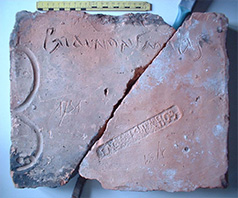
The Brick Collection of the Aquincum Museum includes all ceramic architectural elements from the Roman period excavated in the territory of Budapest.
‘Ceramic architectural elements’ refers to all fired clay objects originally manufactured for architectural purposes, e.g. walling bricks, flooring bricks, ceramic pipes, underfloor and wall heating parts and roof tiles. The collection contains stamped, inscribed, hand-marked and impressed items as well as pieces without any identifying marks. The criteria for collection are based primarily on the requirements and research objectives of the excavations. Objects for research are held in the separate brick storage or the museum’s archaeological small finds collection.
The study of Roman bricks in Hungary has been part of the archaeological work on Aquincum from the very beginning. In 1778 it was a stamped brick Professor István Schönvisner of the University of Pest had found during his excavation of a Roman baths that led him to identify the Óbuda site as part of ancient Aquincum.
Roman provincial archaeologists in Hungary began specialising in different find groups in the 1930s. It was in this period that János Szilágyi was beginning his career. In 1933 he published the first – and to this day only – province-wide collection of brick stamps from Pannonia. The work of Szilágyi, who later became the Aquincum Museum’s director, is still fundamental. He also laid the foundations of the Aquincum Museum’s Brick Collection. The study of Roman bricks in Hungary focuses primarily on questions of architecture, construction techniques and industrial production.
To access the materials, researchers must obtain a permit from the director-general of the Budapest History Museum.


